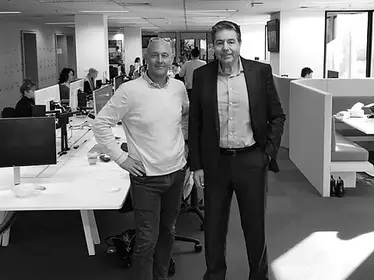AWI is a not-for-profit company that invests in research, development and marketing to increase the long-term profitability of wool for Australian woolgrowers. Based in Sydney, the company has offices in key markets around the world to help increase the global demand and market access for Australian Wool.

Stuart, there has been a lot of changes in the industry since you started out as a jackaroo – can you tell me about some key changes you have observed?
I have seen an enormous amount of change since then. In those days, we had 180 million sheep, where we now have 70 million. Back then, the sophistication of the merino sheep was still maturing – that has come a long way in 30 years. The size of the business (AWI) has dramatically changed too. Back then, it was the days of the Wool Corporation, which had people all around the world. Of course, communication and travel weren't as good as it is today, and that has allowed us to dramatically scale back the human resources we need on the ground in each of the key markets. I think in those days they had two or three thousand people working for the Wool Corporation, where today we have around 200 people. It is a significantly different business. Technology has allowed us to do a lot of things, and I think it's going to continue to evolve.
You deliver research, development and marketing for the Australian wool industry – what is the biggest issue for you at the moment?
We are acutely aware of competitive fibre use at the other end of the supply chain. People are choosing other fibres for one reason or another. There are all sorts of pressure on our fibre from welfare points of view, which we need to be very aware of. Competitive land use at the very consumer end of the supply chain. Convincing the consumer to go in and buy a wool suit, not just a suit or a wool sweater, not just a sweater is a very important part of what we do. Tendering our fibre, as a clean green sustainable fibre that is appealing to the Gen Y and the Gen Z. So that is at that end of the supply chain – the consumer end. Back here on the farm, competitive land use is the opposite to what is happening at the other end of the supply chain. If we don't profile our fibre well and sell it well in the northern hemisphere that sends price signals back down the supply chain, all the way through to the Australian woolgrowers.
Stakeholder management along your global wool supply chain is obviously very critical for you – how do you manage the tension with everyone, from the farmer on one end to the retailer on the other?
It's not easy – it's a balancing act. We have political pressures in Australia all the way up the supply chain. The retailers and brands' main concern is their gross profit. In dealing with all the stakeholders, we have to make sure that they're placated, and that they are getting what they need from us. We need to make sure they understand our business and our strategic intent. It isn't always easy or clear for them to understand why we are going in a particular direction, as opposed to the one they may want us to go. There are plenty of people out there who want to give me a hand with my job. I need to listen to them and make sure that I am explaining myself to them. Often they have very good ideas that we can incorporate into our strategies. There is no particular formula. I suppose it's just good communication – a consultative approach where we listen and engage in open dialogue with all our stakeholders.
What are some of the things (that you can talk about) going on at the moment in the sector?
At any one time around the world, we have around 400 projects running. That is going to come back a bit next year as we have some budget pressures on us that are going to cause some scale back. We are doing everything in the supply chain from in vitro genomics all the way through to retail activation in stores in the northern hemisphere where most of our products sell – 90% of it sells overseas. We are working heavily in agri-technology – we think that offers our growers some huge opportunity in the future. Many of those things are heavily dependant on factors in the consumer world. Consumer electronics that we can apply to farms. We are working very hard on a number of technologies there. We have some interesting patents that we have secured for long-range low-speed Wi-Fi technology. We are working in robotics shearing to find a solution to those sorts of things. They are at the very beginning of the supply chain.
The other end of the supply chain, e-commerce and the way things are going to be sold in the future is very interesting to us, as well. We are making quite a study of that and how that is going to affect retail in the future. We think it will have a big effect – in fact, it is already having an effect. We think that some of the technologies that are emerging through new field communication will have an impact. All phones today are Near Field Communication enabled, so you can use that phone to swipe over a garment and get up all details on the garment such as what's in the garment, how it was produced and potentially, where it came from – that traceability element is something that we are working on.
We are keen to get clean data off the farms. We have built an online trading platform called WoolQ, that brings clean data off the farm. We are working in blockchain technology. We are working at applying synthesised DNA to the fibre so it can be tracked at the other end of the supply chain. I would like to see a day when you can go into a store and see very clearly where that fibre and product has come from. We are getting to a point, with synthesised applied DNA and things like isotopes where you can analyse the fibre and see where that animal has been living to a narrow geographic area. Those things are all very interesting to us. We also know that Gen Y and Gen Z are all very interested in seeing the whole journey that the garment has made from the animal through to the shop door. We think that is a trend that isn't going away, and it is something that we will continue work at. We need to make sure that we set up this industry for the generations that are coming through. The projects we are working on are not designed for someone who is in their fifties like me, they are being built for future generations that are coming out of school now.
You are also responsible for the country's best logo, (the Woolmark logo) – working with and protecting that brand is a huge part of AWI's remit. What is it like having the 'Coke of Australia'?
The Woolmark logo has been on a journey to arrive where it is today. There was an industrial graphic design competition held in 1964, and it was won by an Italian. It was believed that he discovered the logo by playing with a fork in his mashed potatoes, although we are not sure if this is actually true. The logo got a lot of attention and a lot of money put towards it in the 1960s and 1970s. They really profiled the brand, and as such, there was a great brand awareness for that brand during this period. This diminished in the 1980s and 1990s, as the brand didn't get much money spent on it, and of course, if you aren't doing that, you lose brand equity. In the 1990s, a lot of the other countries who were co-owners of the brand withdrew – South Africa, South America, New Zealand, and the UK all pulled out. They decided to go their own way with their own brand.
When I stepped into the role of CEO at AWI, we were again looking for something to put against our fibre. We were looking for something to profile our fibre, and the brand was just sitting there not being very well used – it hadn't had very much money spent on it. We resolved back then, nearly ten years ago that we would profile not only the fibre but also the brand and make sure we put the brand back on a 'pedestal' that it deserves. In terms of well-recognised brands, there are a number of publications that do stories on this every year, and our brand always comes up in the top 20, along with Apple and Shell. It is something that is fully owned by Australian woolgrowers, and we think it is a wonderful mechanism to sell our fibre, and we will continue to do that.



